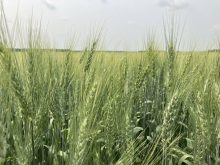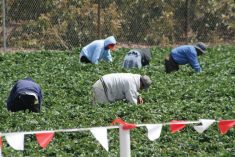The mystery over how seven plants of genetically modified wheat wound up growing next to an Alberta field access road will take some time to unravel.
This high-tech whodunit has regulators scratching their heads to figure out how a known glyphosate-resistance gene from Monsanto got into an unknown variety of wheat hundreds of kilometres from the nearest test site.
And to make matters even more confounding, the find comes nearly 20 years after the last known test using the gene in question.
How the gene got where it was found last summer has been much on the minds of staff at the Canadian Food Inspection Agency, the body leading the investigation.
Read Also

Farming Smarter receives financial boost from Alberta government for potato research
Farming Smarter near Lethbridge got a boost to its research equipment, thanks to the Alberta government’s increase in funding for research associations.
“It’s a very good question, and one that we have asked ourselves,” David Bailey, director of the agency’s plant production division, said in a media briefing.
Monsanto Canada, which was developing glyphosate-tolerant GM wheat in the late 1990s and early 2000s in partnership with Agriculture Canada, is co-operating with CFIA, but the company hasn’t been able to independently verify CFIA’s findings, said spokesperson Trish Jordan.
What’s odd is the specific GM trait (called an ‘event’ in biotech lingo) that CFIA found was dropped by Monsanto in 2000 in favour of other ‘events’ it planned to commercialize, Jordan said.
“It is an event we did field trial research on,” she said. “But the last time we did any research on the germplasm that we were given, which was a hard red spring wheat, was 2000. How do you get six or seven wheat plants showing up in 2017?
“It doesn’t make sense. It shouldn’t happen through cross-pollination. It shouldn’t happen by windblown pollen. It’s just not in the right spot.”
CFIA is just as puzzled.
“The field trials for these were done many hundreds of kilometres away from the discovery site and many years ago so there is no relationship between that given field trial and this particular discovery and this particular location,” Bailey said. “I cannot speculate further in terms of where it may have originated.”
Noticed and tested
The process leading to the discovery began last summer. A commercial herbicide applicator reported wheat plants along an access in southern Alberta had survived a glyphosate treatment. Provincial scientists grew new seedlings for those plants and confirmed they were indeed resistant to glyphosate. The province then notified the CFIA, and its laboratory tests again confirmed the wheat was genetically modified.
With assistance from Monsanto, CFIA was able to conclusively determine that the Alberta GM wheat is not a genetic match to previous unapproved GM wheat releases in the U.S. (in Oregon in 2013, and Montana and Washington in 2014 and 2016, respectively).
“These incidents involved GM wheat lines that are genetically different from the GM wheat found in Alberta,” the CFIA report says. “There is no evidence linking Canada’s GM wheat finding to previous United States cases. Similar to Canada’s finding, GM wheat cases in the United States were isolated incidents, and GM wheat did not enter commerce.”
Unknown origin
It’s also strange that while CFIA has a genetic “fingerprint” of the Alberta GM wheat, it doesn’t know its name.
“The GM wheat has a genetic background that does not match any currently registered wheat in Canada,” Heather Shearer, CFIA’s acting national manager of plant biosafety, told reporters.
“Between the CFIA and the CGC (Canadian Grain Commission), we have approximately 450 wheat varieties on file. This is not a match for any of those 450 wheat varieties.”
The wheats Monsanto experimented with in Canada were AAFC varieties, said Jordon, adding AAFC was also adding Monsanto’s glyphosate-resistance gene to its own wheats. In either case CFIA would know the names of those wheats and could identify them.
The answer could be simpler than it first seems. The unknown wheat is likely an obscure variety Monsanto was working with in the early stages of developing Roundup Ready wheat, said Rene Van Acker, a weed scientist at the University of Guelph who has experimented with Roundup Ready wheat. The variety was Bobwhite, developed by CIMMYT (International Maize and Wheat Improvement Center) in Mexico.
However, a Canadian Grain Commission official says the mystery wheat is not Bobwhite.
It’s also unlikely Monsanto’s gene outcrossed because gene pollen is heavy and doesn’t go far, wheat is self-pollinating and Monsanto did an excellent job of monitoring its Roundup Ready wheat trials, Van Acker said.
Not knowing how this GM wheat got to where it was found is a concern, said the Canadian Biotechnology Action Network, an opponent of genetic engineering.
“We’re relieved this is an isolated contamination case but we’re concerned that the government couldn’t determine how it happened,” network spokesperson Lucy Sharratt said in a news release. “Without knowing the cause, contamination could happen again.”















